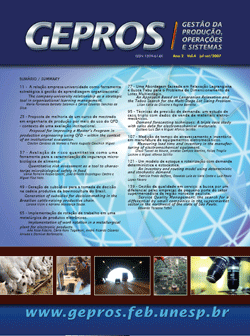Quantitative risk assessment as a tool to characterize microbiological safety in food.
DOI:
https://doi.org/10.15675/gepros.v0i3.167Abstract
Hazard identification is a process well-known by food industries, and its adequate implementation and execution allow for more efficiency in food safety. There are some methods and tools, which are being currently developed to assist in this process; among them, one can singles out risk evaluation. This article aims at describing details regarding risk evaluation and its incorporation in the process of identification of microbiological hazard. As a case study, it was used the type ‘C’ pasteurized milk produced in Brazil. For this purpose, it was used three databases: 1) properties of the food being studied; 2) the characteristics of the product created; and 3) the characteristics of the microorganisms. The databases were confronted and the results analyzed by the Shell Netica in order to quantify the values concerning the levels of danger of the microorganisms. Of all microorganisms analyzed, only two were classified as ‘high risky’; three were considered moderate risky, and the remaining proved to be of low risk. The present study offers xx subsidies for risk managers - those administrating risks to determine the priorities in the actions for food processing, according to the classification of microrganisms found. Keywords: risk assessment, food safety, milk.Downloads
Published
How to Cite
Issue
Section
License
O(s) autor(es) do artigo autorizam a publicação do texto na revista e garantem que a contribuição é original e inédita, não estando em processo de avaliação em outra(s) revista(s). As opiniões, ideias e conceitos emitidos nos textos são de inteira responsabilidade do(s) autor(es), não sendo a revista responsável por tais conteúdos.
Os editores da revista reservam o direito de efetuar ajustes textuais e de adequação às normas da publicação, caso necessário.
Os autores mantêm os direitos autorais sobre o trabalho e concedem à revista o direito de primeira publicação, sendo o trabalho simultaneamente licenciado sob a Attribution 4.0 International (CC BY 4.0), o que permite o compartilhamento do trabalho com reconhecimento da autoria e publicação inicial nesta revista.
Os autores têm autorização para firmar contratos adicionais, separadamente, para distribuição não-exclusiva da versão do trabalho publicada nesta revista (ex.: publicar em repositório institucional ou como capítulo de livro), com reconhecimento de autoria e publicação inicial nesta revista.












